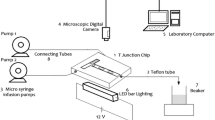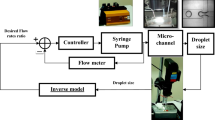Abstract
This paper reports the results of using multiple-ring microchannels for enhancing liquid-liquid extraction performance. The effects of geometrical parameters including ring and distance characteristics on the extraction efficiency were studied. The mass transfer performance was analyzed using Water + Alizarin Red S+1-octanol system. By change in geometrical parameters, the extraction efficiency of multiple-ring microchannels improved up to 62.9% compared with that of the plain one. The performance ratio is defined based on two contrary effects of friction factor and extraction efficiency for evaluating the extraction performance. A performance ratio of 1.5 was achieved that confirmed the advantage of using this type of microfluidic extraction system. Artificial neural network and adaptive neuro-fuzzy inference system were utilized to evaluate the performance ratio of the multiple-ring microchannels. The mean relative error values of the testing data were 0.397% and 0.888% for the neural network and the neuro-fuzzy system, respectively. The estimation accuracy for both models is appropriate, but the precision of the neural network id higher than that of the neuro-fuzzy system. The genetic algorithm approach was employed to develop a new empirical correlation for predicting the performance ratio with a mean relative error of 1.558%.
Similar content being viewed by others
Abbreviations
- A:
-
cross-sectional area of the microchannel [m2]
- A1 and A2 :
-
membership function
- B1 and B2 :
-
membership function
- b:
-
bias
- C:
-
Alizarin Red S concentration [mg/L]
- ci :
-
constant
- D:
-
rings diameter [m]
- d:
-
inner diameter of the microchannels [m]
- E:
-
extraction efficiency
- F:
-
transfer function
- f:
-
friction factor
- H:
-
distance between rings [m]
- kLa:
-
volumetric mass transfer coefficient [1/s]
- L:
-
total length of the microchannels [m]
- m:
-
number of input variables
- N:
-
number of rings
- n:
-
number of experimental data points
- AP:
-
pressure drop [mbar]
- Q:
-
volumetric flow rate [m3/s]
- r:
-
number of neurons
- Re:
-
Reynolds number
- ta :
-
average of the target data
- ti :
-
target data
- tm :
-
fluid residence time [s]
- Um :
-
two-phase mixture superficial velocity [m/s]
- V:
-
volume of the mixing channel [m3]
- W:
-
weight
- X:
-
network input
- x:
-
volume fraction of phases
- Y:
-
final output of the network
- ρ :
-
density [kg/m3]
- μ :
-
dynamic viscosity [Pa s]
- η :
-
performance ratio criterion [-]
- δ :
-
rings characteristic [-]
- β :
-
distance characteristic [-]
- A:
-
average
- aq:
-
aqueous phase
- Exp:
-
experimental results
- in:
-
inlet
- m:
-
two-phase mixture
- org:
-
organic phase
- out:
-
outlet
- Pred:
-
predicted values
- *:
-
equilibrium
References
A. Afzal and K.-Y Kim, Chem. Eng. Sci., 116, 263 (2014).
Y.S. Huh, S.J. Jeon, E.Z. Lee, H.S. Park and W.H. Hong, Korean J. Chem. Eng., 28, 633 (2011).
M. Mohadesi, B. Aghel, M.H. Khademi and S. Sahraei, Korean J. Chem. Eng., 34, 1013 (2017).
M. Sato and M. Goto, Sep. Sci. Technol., 39, 3163 (2004).
Y. Yamasaki, M. Goto, A. Kariyasaki, S. Morooka, Y. Yamaguchi, M. Miyazaki and H. Maeda, Korean J. Chem. Eng., 26, 1759 (2010).
K. Singh, A. Renjith and K. Shenoy, Chem. Eng. Process., 98, 95 (2015).
A.J. Tusek, I. Anic, Z. Kurtanjek and B. Zelic, Korean J. Chem. Eng., 32, 1037 (2015).
J. Tang, X. Zhang, W. Cai and F. Wang, Exp. Therm. Fluid Sci., 49, 185 (2013).
F.H. Kakavandi, M. Rahimi, O. Jafari and N. Azimi, Chem. Eng. Process., 107, 58 (2016).
L. Zhang, F. Xie, S. Li, S. Yin, J. Peng and S. Ju, Green. Process. Synth., 4, 3 (2015).
A. Kaewchada, S. Tubslingkra and A. Jaree, Chem. Eng. Res. Des., 117, 784 (2017).
D. Das, S. Duraiswamy, Z. Yi, V. Chan and C. Yang, Sep. Sci. Technol., 50, 1023 (2015).
S. Hossain, M. Ansari and K.-Y Kim, Chem. Eng. J., 150, 492 (2009).
I. Shah, S.W. Kim, K. Kim, Y.H. Doh and K.H. Choi, Chem. Eng. J., 358, 691 (2019).
A.A. Babaei, A. Khataee, E. Ahmadpour, M. Sheydaei, B. Kakavandi and Z. Alaee, Korean J. Chem. Eng., 33, 1352 (2016).
M. Molashahi and H. Hashemipour, Korean J. Chem. Eng., 29, 601 (2012).
M.S.V. Krishna, K.M.S. Begum and N. Anantharaman, Powder Technol., 307, 37 (2017).
A. Lashkaripour, M. Goharimanesh, A.A. Mehrizi and D. Densmore, Microelectron. J., 78, 73 (2018).
F.H. Kakavandi, M. Rahimi, M. Baniamer and H.R. Mahdavi, Chem. Pap., 71, 2521 (2017).
Y. Zhao, G. Chen and Q. Yuan, AIChE J., 53, 3042 (2007).
D. Tsaoulidis, V. Dore, P. Angeli, N.V. Plechkova and K.R. Seddon, Chem. Eng. J., 227, 151 (2013).
M. Rahimi, S.R. Shabanian and A.A. Alsairafi, Chem. Eng. Process., 48, 762 (2009).
S.R. Moosavi, D.A. Wood, M.A. Ahmadi and A. Choubineh, Nat. Resour. Res., 28, 1619 (2019).
M.A. Ahmadi, M. Ebadi and A. Yazdanpanah, J. Pet. Sci. Eng., 123, 7 (2014).
M.A. Ahmadi, M. Masumi, R. Kharrat and A.H. Mohammadi, Chem. Eng. Technol., 37, 409 (2014).
M.A. Ahmadi, Math. Probl. Eng., 2015, 1 (2015).
M.A. Ahmadi and S.R. Shadizadeh, Fuel, 102, 716 (2012).
M.A. Ahmadi, Fluid Phase Equilib., 314, 46 (2012).
M.A. Ahmadi, J. Pet. Explor. Prod. Technol., 1, 99 (2011).
M.A. Ahmadi and A. Ahmadi, Int. J. Low Carbon Technol., 11, 325 (2016).
M.-A. Ahmadi, M.R. Ahmadi, S.M. Hosseini and M. Ebadi, J. Pet. Sci. Eng., 123, 183 (2014).
M.-A. Ahmadi, A. Bahadori and S.R. Shadizadeh, Fuel, 139, 154 (2015).
M.A. Ahmadi, M. Ebadi, P.S. Marghmaleki and M.M. Fouladi, Fuel, 124, 241 (2014).
M.A. Ahmadi and M. Ebadi, Fuel, 117, 1074 (2014).
C.C. Yuen, S.K. Gupta and A.K. Ray, J. Membr. Sci., 176, 177 (2000).
Y. He, J. Pei, C. Srinivasakannan, S. Li, J. Peng, S. Guo, L. Zhang and S. Yin, Hydrometallurgy, 179, 175 (2018).
S. Acharya and S. Mishra, Sep. Sci. Technol., 52, 1660 (2017).
E.A. Dil, M. Ghaedi and A. Asfaram, Ultrason. Sonochem., 34, 27 (2017).
A.H. Mehrkesh, S. Hajimirzaee, M.S. Hatamipour and T. Tavakoli, Chem. Eng. Technol., 34, 459 (2011).
S. Ghoreishi, A. Hedayati and S. Mousavi, J. Supercrit. Fluids, 112, 57 (2016).
A. Hedayati and S. Ghoreishi, Chem. Prod. Process. Model., 11, 217 (2016).
Author information
Authors and Affiliations
Corresponding author
Rights and permissions
About this article
Cite this article
Hosseini, F., Rahimi, M. Experimental study and artificial intelligence modeling of liquid-liquid mass transfer in multiple-ring microchannels. Korean J. Chem. Eng. 37, 411–422 (2020). https://doi.org/10.1007/s11814-019-0453-1
Received:
Accepted:
Published:
Issue Date:
DOI: https://doi.org/10.1007/s11814-019-0453-1




